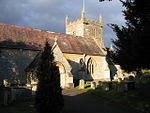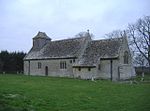Ashton Keynes
Civil parishes in WiltshireEngvarB from September 2013OpenDomesdayPopulated places on the River ThamesVillages in Wiltshire

Ashton Keynes is a village and civil parish in north Wiltshire, England which borders with Gloucestershire. The village is about 5 miles (8 km) south of Cirencester and 3.5 miles (5.6 km) west of Cricklade. At the 2011 census the population of the parish, which includes the hamlet of North End, was 1,400.The village lies within the Cotswold Water Park and on both sides of the River Thames, which has many channels here. It is about 6.5 miles (10 km) from the river's source at Thames Head.
Excerpt from the Wikipedia article Ashton Keynes (License: CC BY-SA 3.0, Authors, Images).Ashton Keynes
Park Place,
Geographical coordinates (GPS) Address Nearby Places Show on map
Geographical coordinates (GPS)
| Latitude | Longitude |
|---|---|
| N 51.645 ° | E -1.935 ° |
Address
Park Place
Park Place
SN6 6NX
England, United Kingdom
Open on Google Maps







